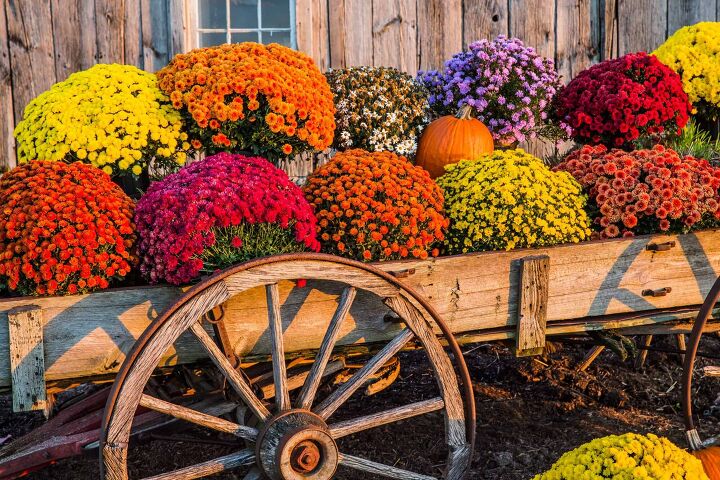Why Are My Mums Turning Brown? (Here's What You Can Do)

Chrysanthemums, a.k.a. mums are a wonderful, vibrant choice for a fall garden. Many gardeners love them because they are strong, hardy plants who thrive even when slightly neglected.
But although they are resilient, easy-going plants, they are not immune to an untimely death.
If your mums are turning brown, it is likely due to improper water, disease, or insect infestations. Begin by looking to see if they have been oversoaked by rain or if they are excessively dry. Excessive water can lead to fungi growth, which can be identified by leaf spots or brown rust.
Related Content: Do Deer Eat Mums? | Types of Plants | Garden Hose Repair Kits
Do You Need Landscaping Services?
Get free, zero-commitment quotes from pro contractors near you.

What is Causing My Mums to Turn Brown?
Diseases
When their soil is heavily saturated, or the plant stays wet too much, mums are susceptible to fungi diseases. Two of the most common types of fungi that affect mums are leaf spot and brown rust.
Leaf Spot: This is caused by several types of fungi that cause the plants to turn brown and die. You can recognize it by its characteristic dark brown or black irregular spots. They eventually dry, turn a lighter color and begin to crack.
Brown Rust: This is caused by a kind of fungus where leaves start to develop swollen brown areas on their undersides. You may also notice pale areas on the upper leaf surfaces. Plants that are severely infected are very weak and will not bloom properly.
Wilt disease: This disease attacks the vascular tissue of the plant. The early symptoms include yellowing and browning leaves. The leaves start to die from the base of the plant and up. causing brown streaks to appear.
Flowers with this disease may wilt and die suddenly. Wilt disease lives in the soil and enters the plant via the roots. It later attacks the vessels of the stem and cuts off its water supply.
Insect Pest Infestations
Sucking insects are notorious for attacking mums. Some common culprits include mealybugs and aphids. They have been known to drain juices from the leaves of the plant, in turn causing them to brown.
There are also mites called thrips that attack the buds and flowers of the plant. They pierce the cells of the tissues and suck out the contents, which causes the surrounding tissues to perish.
Poor Environmental Conditions
Soil that is too wet or too dry can cause the mums to weaken. This makes them more vulnerable to fungi diseases as well as insect infestations.
Mums can also be ruined if they are hit by early frost or damaged by heavy rain. You may see them start to brown, or simply wilting, failing to bloom, or dying in this situation.
Treatment of Brown Mums
Leaf Spot Treatment
To treat this disease, promptly hand pick and dispose of the infected leaves. Regular cleaning of dead plant debris around the garden can also keep the spore populations under control.
When the spots on the affected leaves are damp, this is when the bacteria are active. Therefore, you should avoid handling the wet infected plants or splashing water from the infected plants onto the healthy ones.
Rust Treatment
Pick off the infected leaves as soon as you can. Be sure to set any new plants farther apart and ensure that they have proper ventilation.
Preventative FungicideThis can prevent or sometimes reduce the effects of fungi diseases. The best time to use fungicide for prevention is when new plant growth happens in the spring. At that time, choose a fungicide best suited for flowering plants.
Wilt diseasesUnfortunately, this cannot be treated. If you believe your plant is afflicted with wilt disease, it’s best to toss it and start over with fresh, sterilized soil.
InsectsTo deal with insects, simply rinse insects off with a strong stream of water to remove them from the plants. You can also use an insecticide to kill them.
Tips to Prevent Mums from Turning Brown
- Make sure the pot your mums are in has holes to allow for proper drainage. Make sure the plants are in an area where air can freely circulate around them.
- Wilt diseases can only be prevented by not planting flowers in the same spot where others have been afflicted with the same disease.
- Insects, alas, are unavoidable. Just be sure to inspect your plants frequently for signs of infestation.
- Cover your plants with a plastic tarp when you expect heavy rain or frost to protect them. There are also varieties of mums that are more frost-resistant if that is a frequent concern in your area.
- Mulch heavily to keep the soil moist can prevent brown blossoms and promote healthier flowering
- Fungal diseases are often caused by overhead watering. Be sure to water your mums gently at ground level, avoiding the leaves. Do not overwater your mums.
Best Growing Conditions for Mums
Here are several tips to keep in mind to prevent your mums from turning brown again in the future. Following these tips will give them their best chance of staying healthy and disease-free.
Planting Location
Mums are big fans of the full, early sun. While they will do well with 5-6 hours of sunlight daily, they’ll fare even better with as much sunlight as possible. Give them a little shade to protect them from scorching on hot summer days.
Mums are susceptible to mildew, so it’s important that their leaves and stems stay dry. The morning sun, ample air circulation, and effective water drainage will keep them dry.
Mums bloom when they sense shortening days and longer nights. Try not to plant them near any streetlights or other sources of light at night.
When to Plant
Mums do best when planted in the early spring, after the freezing weather has subsided.
Some mums planted in the fall will be able to survive the winter if they are planted immediately. But your odds for success are far greater when you plant them in the spring.
Soil Conditions
Mums can survive in most types of soil, but they do especially well in well-draining soil with consistent, even moisture.
Mums benefit from light yet frequent feeding with a well-balanced fertilizer.
How Often to Water
Mums need even, consistent watering for best results. Water them regularly throughout spring, summer, and fall. They like early morning watering to a depth of about 6-8 inches.
Caring for Mums
As soon as your mums are about 6 inches tall, pinch off the tips to encourage more blooms. When they reach a foot, pinch them back again.
If you want heavy fall-blooming, pinch back every few weeks until July. This will encourage heavier fall blooming. The last time you pinch them back should be about 3 months before the desired bloom time.
Related Questions
How can I tell if my mums are dead?
Start by examining the mums’ roots. If they look brown and dry, the plant is most likely dead. If the roots look white and healthy, the plant is alive. It will need some extra attention to survive.
Can I revive my mums?
If your mums suffered a rough winter it may be possible to revive them. Start by picking off all the dead parts all the way down to the roots. Then add some fresh fertilizer to the soil. Make sure the pot is in the sun, and water it well. Keep an eye on it, and prune it as described above once it starts budding.
Do You Need Landscaping Services?
Get free, zero-commitment quotes from pro contractors near you.

Wrapping Up
It can be very frustrating when your mums start to turn brown. But knowing the early signs of trouble and how to prevent them can be extremely helpful. Knowing these tips and tricks for preventing disease in mums will help you earn that “green thumb” status.

We are a team of passionate homeowners, home improvement pros, and DIY enthusiasts who enjoy sharing home improvement, housekeeping, decorating, and more with other homeowners! Whether you're looking for a step-by-step guide on fixing an appliance or the cost of installing a fence, we've here to help.
More by Upgraded Home Team












![The 5 Best Angle Grinders – [2022 Reviews & Buyer's Guide]](https://cdn-fastly.upgradedhome.com/media/2023/07/31/9071326/the-5-best-angle-grinders-2022-reviews-buyer-s-guide.jpg?size=350x220)














![Standard Dining Room Table Dimensions [for 4, 6, 8, 10 and 12 People]](https://cdn-fastly.upgradedhome.com/media/2023/07/31/9074335/standard-dining-room-table-dimensions-for-4-6-8-10-and-12-people.jpg?size=350x220)